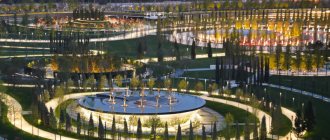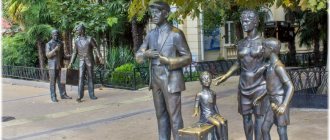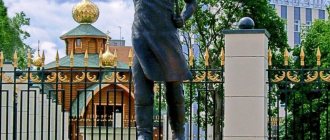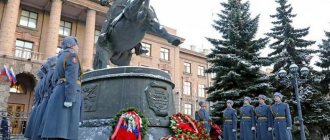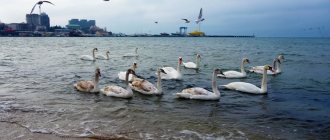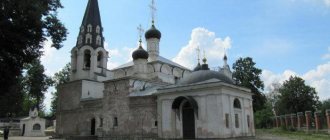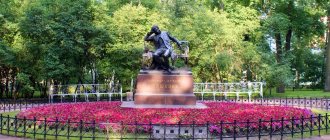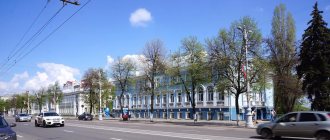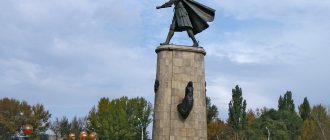For some reason, indigenous residents prefer to call Krasnodar Ekaterinodar. I think this name seems more euphonious to them. In any case, it sounds very patriotic. Many townspeople still refuse to recognize the new name of the city. On benches throughout the city there is a beautiful letter “E”, which takes us back to the initials of the great empress, Catherine II, she founded the city in 1793 by her decree. Personally, I like everything about Krasnodar, but what especially attracted my attention was not the warm southern climate and the opportunity to go to the sea for the weekend, but the abundance of parks, fountains (especially attractive in the summer heat) and monuments.
It is about the monument to Catherine that my story today will be.
A little history
It is worth mentioning not only the bare date, but also the place where Krasnodar was founded. It is believed that the Cossacks established their first settlement right where the monument to Catherine II now stands. Currently it is in Catherine Square (everything here is imbued with the spirit of the Empress), near Pushkin Square and the beginning of Krasnaya Street.
The monument was originally erected in 1907. It was believed that the empress was not only the founder of the city, but also its patroness, almost a saint. Unfortunately, as we know, the Bolsheviks did not tolerate any personality cults other than the leader, and demolished the monument by 1920.
Only in 2006 was it put back in its rightful place, and it still stands there and delights with its greatness not only me and onlookers, but also the real patriots of the region. Many newlyweds come here to take beautiful pictures and receive the blessing of the great Catherine II.
How to get to the monument to Catherine
If you are familiar with Krasnaya Street, the easiest way for you will be to take bus 2E to the Musical Theater stop and then walk, which will take about 10 minutes at a calm pace. At the intersection of Krasnaya and Pushkin there will be a park, in the center of which the monument is located.
If you get off at Sovetskaya, then minibuses No. 2, 12, 21, 24, 27, 28, 30 and 39 are available. By No. 177 you can get to the “City Garden” stop, from where you will already be able to see Catherine’s Square. You can also get to the City Garden stop by trams No. 4 and 2, and also by buses No. 101, 107a, 124a, 126a, 127a, 7a, 7b.
Why Krasnodar is the dog’s capital and how the Cossacks disposed of the legacy of Catherine II
“The northerners lied to you about the ferocity of February: about snowstorms, about drifts, about pink-nose frost.
The sun burns Krasnodar like redness on your cheeks. Beauty! <…> Even if there are a couple of puddles, a hundred suns are dancing in the puddles. This is not a dog’s wilderness, but a dog’s capital.”
In his poem of 1926, Vladimir Mayakovsky gave the city another unofficial title of the capital - Sobachkina. Oddly enough, such a gesture can be explained quite logically.
The revolution left many purebred dogs without eminent owners, who wandered around the city in huge numbers and had fun as best they could. People call such gatherings “dog weddings.”
Once, a poet of the proletariat witnessed such a wedding during a trip to the southern capital. This probably made an impression on him, which he concluded in poems dedicated to Krasnodar. Much later, the townspeople immortalized Mayakovsky’s words in a sculpture: a bronze dog couple, holding their paws, takes an evening promenade. They met in a popular place for dates - near a building with a clock at the intersection of Krasnaya and Mir. The romantic monument has acquired its own beliefs: you need to rub the nose of one of the dogs - and good luck will accompany you in love, and if you touch the paw, then any journey will end well.
Krasnodar has existed for about a hundred years: until 1920 it was Ekaterinodar. In 1792, Empress Catherine II presented the Zaporozhye Cossacks with a Charter, according to which the lands from the Kuban River to the Sea of Azov, and from the east from the mouth of the Laba to present-day Yeisk, were transferred to the Cossacks for eternal possession.
The Cossacks quickly developed the donated lands: they transported their families and founded a kuren (military settlement), which later became Yekaterinodar.
Now Krasnodar is a sunny and friendly city, the unofficial capital of Kuban and the entire Southern Federal District - attracting residents from all over Russia. Some are on vacation and some are for permanent residence. The author of this text, like other seekers of a better life, left Omsk and moved to Krasnodar across the sea and prospects. For slackers like scribblers and bloggers, there really are more of them here.
Krasnodar is more than 50% private sector. This is probably due to the peculiarity of the local population, who are accustomed to cultivating their own piece of land. There are often places where barn-like houses coexist with new business centers and high-rise buildings.
Blogger Varlamov called the appearance of the city “architectural vomit” - such an assessment is associated with the widespread unauthorized construction, the construction of which is typical for southerners. Here this is practically not prohibited: they are unlikely to report you if you are not bothering anyone, and the authorities do not conduct raids to identify illegal buildings.
The famous feature and flavor of Krasnodar is its dialect. The Kuban-Ukrainian “sho” and “la” can be heard here from every corner at a distance of 150 meters from the center. And you will have to look for eggplants at the market, because they are “blue”. We also sincerely do not understand why no one can distinguish poles from apricots. However, these are not all the colloquial quirks of the locals. Ubiquitous swearing is not such a feature for Russia, but Krasnodar swearing has historical roots.
Do you remember Repin’s painting “The Cossacks Write a Letter to the Turkish Sultan”? A reproduction of the canvas, cast in bronze in human size, is installed at the intersection of Krasnaya and Gorky. The monument is made with scrupulous precision and even has an interactive character: the protruding part of the picture serves as a place where anyone can sit, becoming, as it were, part of the action, which consists of inventing the most offensive epithets for the Turkish ruler and his relatives.
Foul language, of course, is such a reason for pride. But not so long ago, Krasnodar residents received another object of desire - the local “Coliseum”, which is actually called the new arena of FC Krasnodar. This is a stadium that was built last year at the expense of the former general director of the Magnit supermarket chain, Sergei Galitsky, with the participation of Artemy Lebedev’s studio. The stadium was assigned the 4th UEFA category, which implies the right to host the final matches of the World and European Football Championships.
Galitsky does not name the cost of the project, but in one of his interviews he admitted that the stadium will never pay off. He associates it with his home, so entry into the stadium with seeds is prohibited: “Would you like it if they spit at your house?”
Last year, a park with an area of 23 hectares, built at the expense of a businessman, also opened next to the stadium. On its territory there is a fountain with a waterfall and a pond, which in winter turns into an outdoor skating rink; a streetball court, a climbing wall, a skate area for extreme sports, a musical labyrinth for children - with walls made of ornamental bushes, an outdoor cinema for 200 people and a ropes course.
Sergei Galitsky is generally a symbolic personality for Krasnodar. In addition to the fact that his brainchild (Magnit) “feeds” half the country, he himself made a significant contribution to the development of Krasnodar: in addition to the stadium, he is also investing in the reconstruction of the Aurora cinema, since the city authorities do not have enough money for this, and The Krasnodar football club, under his leadership, was included in the Premier League.
You can get to Krasnodar from Moscow by almost any type of transport: by plane - for 5-7 thousand in 2 hours, by train - for 3-5 thousand per day or by Blablacar - for 2 thousand, depending on your luck. If you finally arrive and decide to take a walk around Krasnodar, according to tradition, you should start from the central street - Krasnaya. The city was unlucky with its historical center: it was almost completely destroyed during the revolution and the Great Patriotic War. Walk along the central alley on Krasnaya Street from Aurora towards Theater Square. This is the most well-groomed and popular part of the city.
Along the way you will come across a singing fountain, a flowerbed-clock that shows real time, an alley of spreading centuries-old plane trees, the same building from “Our Russia”, the royal arch, a monument to students (Gaidaev’s Shurik and Lidochka).
Here you can snack on burgers or half a kilo of shawarma at Joburg. If you want to try local cuisine, go to Borschberry. You will be greeted with bread and salt at the entrance: several types of liqueurs and snacks will be offered. After this there is no turning back, and you must go, which, most likely, you will not regret. When choosing a dish, there should be no question - the choice is obvious. If you are a company of several people, then the food will be served to everyone at the same time (do you also get annoyed when your friends’ order has already been brought, and you are patiently sipping some water?). The presentation is accompanied by the motto “One, two, three - Borschberry!” Dumplings, garlic and sour cream included. At the end of your meal, you will be invited to play a game with the opportunity to win a prize. Although “Borschberry” is located in the city center and the service is at the proper level, the prices here are not “bitter”, as, for example, in “Magyar”. A plate of borscht will cost 300 rubles, but you will remember it for a long time. Magyar, mentioned earlier, is a chain of themed restaurants, each of which specializes in its cuisine and has its own charm: Gray Goose - if you have money and like oysters; WokCafe - if you want to try real ramen, like in Naruto; “Coral Beads” - if you want to spend a romantic evening on the terrace 50 meters from the singing fountain; “Pinocchio Djan” - if you want something spicy and unusual, for example, to rub shoulders with the waiter “for life”; Grill Bar - if you want well done marbled veal steak, but you definitely haven’t tried such grilled vegetables anywhere. If you order delivery from this restaurant chain, your food will arrive not a minute earlier or later than the appointed time. But you will have to fork out 3-4 thousand - the service corresponds to the price.
If instead of gluttony your soul demands revelry, go to Krasnoarmeyskaya. The narrow street is the former estate of the military ataman of the Black Sea Cossack army, on both sides it is strewn with bars and clubs, which are located in historical buildings.
Every night there is a bacchanalia of drunken youth, taxi drivers and sellers of flowers and sandwiches. Here you will find both eateries with free entry and no face control, as well as luxury establishments that an ordinary city dweller can only look disapprovingly at from afar.
You can also become culturally enlightened in the city. If your time and plans allow, visit the One Theatre, and specifically the production of The Lonely West based on the play by Martin McDonagh. You definitely won't regret it. The theater's repertoire is interesting, and tickets are inexpensive (from 350 rubles), so it is very popular among young people.
There are numerous national diasporas in Krasnodar, and the city is considered safe. You will want to argue and cite the example of a sensational story about a cannibal, but most of the rumors that a family of cannibals operated in the city for 30 years and ate 20 people are not true. According to the Investigative Committee, there are signs of cannibalism in this case, but this is the only incident.
But there are no problems with juvenile crime in Krasnodar: ten years ago a law came into force prohibiting children under 18 years of age from being on the street after 10 p.m. unaccompanied by an adult. Therefore, the risk of being beaten by a Cossack’s whip is higher than by a crowd of youngsters.
Of course, if your hobby is not naked dancing in front of churches or outright hooliganism. Cossack raids in Krasnodar are carried out regularly, but locals perceive them more like mummers’ walks.
Urban legends have the same Kuban flavor. According to rumors, in the 1980s, five former submariners stole a submarine from Victory Park, an open-air museum of military equipment, to go buy vodka. That summer day, the men celebrated Navy Day and, warmed by the summer sun (and perhaps even stronger), after a tour of the submarine, they climbed into the control room and started the engine. It is noteworthy that ten years later, when the boat functioned only as an exhibit, a certain amount of fuel was found in it, and the engine was in working condition. However, the boat was soon intercepted near the Turgenevsky Bridge. How true this is, history is silent, citing the fact that the incident was hushed up by the authorities in order to avoid the resignation of leading officials.
Krasnodar residents are proud of their fertile land, agriculture and warm climate. Every deep-rooted local resident firmly believes that this is the best place in Russia: the roads are like in Europe, the winter is short, and the sea is two hours away by car. When you arrive in the summer, you will take away the main southern souvenir - skin tanned along the contour of your clothes. Krasnodar is an ordinary city with its own history, which promises to be long. This city is definitely worth coming here at least once. Not for good. We already have traffic jams here.
Features of the location of the monument to Catherine
Some time ago I lived two blocks from the park, so I visited there often. Even in winter, many people walk around the monument; it is especially attractive to tourists.
The monument is located in the center of the park and is surrounded by a fence. This circumstance upset me a lot when I first saw him. I really love taking pictures, so I wanted to get as close to the monument as possible, at least at a distance at which the fence would not be visible in the image.
Nevertheless, I found a way out by moving further away, so that Catherine was visible in all her glory, and the fence was not so striking. As for the limiter, its location around the monument is justified. I wouldn’t want teenagers to paint such a majestic monument out of youthful contradiction (or as a sign of revenge on the empress for getting a bad mark on an unlearned topic from 18th-century history).
Monument in the life of Krasnodar
There is a belief that Saint Catherine is able to protect everyone who turns to her with such a request from mistakes and dangers. It helps to find peace in the family and well-being in the home, protects and helps pregnant women, protects newborns from illnesses, and helps to find a faithful life partner.
Therefore, here you can often see townspeople and guests of Krasnodar reading a prayer to the Holy Great Martyr Catherine, revered as an example of piety and a helper in good deeds.
In the life of the city, the monument has become a traditional place where newlyweds come on their wedding day. Passing under the figure of the Saint, the lovers ask to bless and strengthen their union.
Click to open in a new tab
What is depicted on the monument
The fence protects not only Catherine from unlucky vandals. Next to her (on the left) is Prince Potemkin and the atamans of the Cossack army (on the right). Also carved in stone is a list of their victories over the entire history of the participation of the Cossacks from Kuban. Nearby there is a letter inscribed, which just confirms the fact of transfer of the land to the atamans.
The monument has truly royal dimensions: its height is 13.8 meters, width is 16 meters.
Composition
The Empress, dressed in purple, stands, holding a scepter and orb in her hands. On the pedestal in the central part there is the text of the Highest Charter on June 30, 1792, granted to the Cossacks in the Kuban. On the left of the pedestal is Prince G.A. Potemkin against the backdrop of battle banners, on the right are famous Cossack atamans, it is believed that these are the first three Koshevy atamans of the Black Sea Cossack army - Anton Golovaty, Sidor Bely and Zakhary Chepega; on the back side there is a kobzar who holds a bandura, accompanied by a guide. Engraved on the monument is a list of victories won by Russia with the participation of the Kuban Cossacks.
Park around the monument to Catherine
There is a park with cozy benches around the monument. Personally, I like it because there is no “eye-to-eye” effect, like in many other city recreation areas. It’s very comfortable here to sit and read a book or just talk on the phone and be sure that there are no outside observers.
Despite the central location, it seems that I am relaxing in nature, outside the city. In a large populated area, there is often a particular lack of something natural, close to the sources. We lived nearby, and I made it a rule, being able, to go there every day. The air there is clean, strangers could not disturb me. A pleasant bonus of such walks was that often some performer (usually a guitarist or violinist) sat on one of the neighboring benches and played his melody. If he played well and I liked it, I stayed and listened. Moreover, all this was so unobtrusive that at any moment I could get up and go about my business.
The Holy Great Martyr Catherine, the patroness of Ekaterinodar (Krasnodar), stands on a huge pedestal in the form of a bell, decorated with four gilded angels.
According to the authors of the project, Moscow sculptors Vitaly Shanov and Daria Uspenskaya, anyone can go inside the bell and ask for the saint’s heavenly protection. The newlyweds were the first to pass under the shadow of Saint Catherine, having received her unspoken blessing. This happened during the opening ceremony of the monument and became a beautiful wedding tradition in the city.
“Today we consecrated a wonderful monument that adorns our beautiful city, the capital of our Kuban, which will gather us here to reflect on the eternal. Saint Catherine will protect our city from enemies visible and invisible, and everyone who comes to her will receive what they ask for,” Metropolitan Isidore said during the consecration ceremony.
The almost eight-meter monument is made of bronze; it took the author a year and a half to make it. The magnificent sculpture was unveiled and dedicated on April 24, 2009.
Brief Life of the Holy Great Martyr Catherine
Saint Catherine was born in Alexandria in the second half of the third century. She came from a noble family and was distinguished by her bright mind, learning and beauty. Many rich and noble suitors sought her hand, and her mother and relatives persuaded her to agree to marriage. But Catherine was slow to answer and told her loved ones: “If you want me to get married, then find me a young man similar to me in beauty and learning.”
God arranged it in such a way that Catherine met one hermit elder, a man of a bright mind and a righteous life. Discussing with Catherine the merits of her suitors, the elder said: “I know the Bridegroom who is superior to you in everything. There is no one like him." Then he gave her an icon of the Blessed Virgin, promising that it would help her see the extraordinary Bridegroom.
The next night, Catherine imagined in a light dream that the Heavenly Queen, surrounded by angels, was standing in front of her and holding in her arms the Child, shining like the sun. In vain did Catherine try to look at His face: He turned away from her. “Do not despise Your creation,” the Mother of God prayed to her Son, “tell her what she must do to see Your bright face.” “Let her return to the elder and find out from him,” answered the Youth. The wonderful dream deeply struck the girl. As soon as morning came, she hurried to the old man, fell at his feet and asked him for advice. The elder explained to her in detail the true faith, told her about the heavenly bliss of the righteous and the death of sinners. The wise virgin understood the superiority of the Christian faith over the pagan faith, believed in Jesus Christ as the Son of God and accepted holy baptism. After her baptism, divine light penetrated her and filled her with great joy. When Catherine returned home with a renewed soul, she prayed for a long time, thanking God for the mercy shown to her. Having fallen asleep during prayer, she again saw the Mother of God. Now the Divine Youth looked at her graciously. The Most Holy Virgin took the maiden’s right hand, and the Youth put on her a wonderful ring, saying: “Know not the earthly bridegroom.” Catherine realized that from that moment she was betrothed to Christ and woke up with even greater joy in her heart. After that, she completely changed and became modest, meek and merciful. She began to pray to God often, asking for guidance and help. One goal inspired her: to live for Christ.
Soon, Maximian (286-305), co-ruler of Emperor Diocletian, arrived in Alexandria. He sent messengers to the cities of Egypt to convene the people for a holiday in honor of the pagan gods. Catherine mourned that the tsar, instead of helping to educate the people, was further instilling pagan superstitions. When the holiday arrived, she came to the temple where the priests, nobles and people gathered and fearlessly said to the king: “Aren’t you ashamed, king, to pray to vile idols! Know the true God, beginningless and infinite; to them kings reign and the world stands. He came down to earth and became a man for our salvation.”
Maximian was angry with Catherine for disrespecting his royal dignity and ordered her to be imprisoned. Then he ordered learned people to convince Catherine of the truth of the pagan religion. For several days, they presented to the girl various arguments in favor of the pagan religion, but Catherine, with her logic and reasonable arguments, smashed them to dust. She proved to them that there can only be one wise Creator of everything, who with his perfections infinitely rises above the pagan deities. In the end, the pagan sages admitted themselves defeated by Catherine’s all-crushing logic. Having failed on intellectual grounds, Maximian, however, did not give up on his intention to convince Catherine. Having called her, he tried to seduce her with gifts, promises of honors and glory. But Catherine remained incorruptible.
Maximian had to leave the city for a short time. His wife, Queen Augusta, who had heard a lot about Catherine's wisdom, wanted to see her. Having met and talked with Catherine, Augusta believed in Christ and accepted the Christian faith.
When Maximian returned to Alexandria, he again sent for Catherine. This time he took off the mask of goodwill and began to threaten Catherine with torture and death. Then he ordered wheels with sharp teeth to be brought and ordered her to be put to this terrible execution. But as soon as the torment began, an invisible force crushed the instrument of torment, and Saint Catherine remained unharmed. Queen Augusta, having learned about what had happened, appeared before her husband and began to reproach him for how he dared to rebel against God Himself. The king was furious at his wife’s interference and ordered her to be killed immediately.
The next day, Maximian called Catherine for the last time and invited her to become his wife, promising her all the blessings of the world. But Saint Catherine did not want to hear about it. Seeing the futility of all his efforts, the king ordered her to be put to death, and the warrior cut off her head in 304.
Subsequently, the holy remains of the Great Martyr Catherine came to Mount Sinai and since then have been kept here in a monastery named after her. Emperor Peter the Great donated a precious shrine to her relics. (taken from www.sedmitza.ru) (read the full life on www.pravoslavie.ru)
Where to eat nearby
Another thing I would like to mention is the coffee. I walked there in the winter-spring period, so even though it was south, I wanted to warm up. One day I found one establishment (it’s hard to call it a cafe, because the establishment doesn’t even have its own name) while walking down the street looking for a gift and going into all the shops I came across. So, since the door was still there, albeit without a sign, and rather inviting-looking, I decided to try to get inside.
This place turned out to be a small buffet in a strange style, either vintage or, on the contrary, modern eco. Lots of wood, the smell of oranges and coffee, a small counter with local pastries and a couple of chairs along the window. You can have a snack, look out the window at the city (although there are not many people in this area during the cold season), no one will bother you. One way or another, I went to this place almost every day. If anyone is interested, the address is: Krasnaya, 16, transparent door next to Kubanloto.
City's legends
It is believed that countless treasures were originally laid under the empress’s monument. It all started with the fact that one ardent lady of great wealth threw a ring at the feet of the ruler’s monument as a sign that once her relative did not achieve the due honor from Catherine II, and now she does not need the jewelry that she got with such difficulty and passed down the family line . That is why not only newly-made spouses, but also wealth seekers come here in the hope of the favor of Her Imperial Majesty.
Monument to the Holy Great Martyr Catherine
Saint Catherine
In Kuban, the holy great martyr has long been revered as an example of piety and a helper in good deeds. She lived in Alexandria in the 4th century and suffered for the Christian faith when she was 18 years old. Since then, her memory has lived on among many generations of Christians around the world. The saint was the heavenly patron of Empress Catherine II, who in 1792 granted new lands on the Kuban River to the former Zaporozhye Cossack army. The emerging city received the name Ekaterinodar and was renamed during Soviet times. Thus, the history of present-day Krasnodar is connected with the names of the holy great martyr and the Russian empress.
Saint Monument
An eight-meter bronze monument rises above the square. The Holy Great Martyr Catherine stands on a pedestal made in the form of a bell. The sculpture was created in compliance with Orthodox iconography. According to the canons, the image of the saint is modest and fragile, in her hands is a cross, and on her head is a crown. It is believed that she was the daughter of the ruler of Alexandria of Egypt, Const. The bell-pedestal is decorated with figures of angels placed in small niches, emphasizing the sophistication of the image of the saint.
It took the author a year and a half to make the entire monument. The composition was conceived not only as a monument - townspeople can enter inside the bell-pedestal, walk under the monument and thus feel themselves under the protection of St. Catherine.
The cascade of fountains with color lighting gives the sculptural composition a modern look, which organically fits into the appearance of the city. The monument looks especially impressive in the evening.
On the same axis with the monument is the Triumphal Arch, called the Royal Gate. It was destroyed during the Soviet years and restored on the eve of the opening of the sculpture of the saint.
Monument in the life of the city
There is a legend that the Holy Great Martyr Catherine helps those who turn to her in prayer to find a life partner. In the life of the city, the monument has become a traditional place where newlyweds come on their wedding day. Passing under the figure of the saint, the lovers ask to bless and strengthen their union.
The monument to the Great Martyr is a tribute of love and respect to the patroness of the city, Saint Catherine. This is a symbol of the revival of the Orthodox faith in the city once called Ekaterinodar.
One day…
One day a girl came up to me with a camera and offered to do a free photo shoot for her portfolio. It was March, the first tulips had just bloomed, and the photographs with Catherine in the background turned out very bright.
For some reason I remember this day. I once again noted the friendliness and openness of the local population (photo attached). I told this story because in the park near the monument to Catherine II you can expect not only fresh air and health benefits, but also a similar pleasant surprise :).

